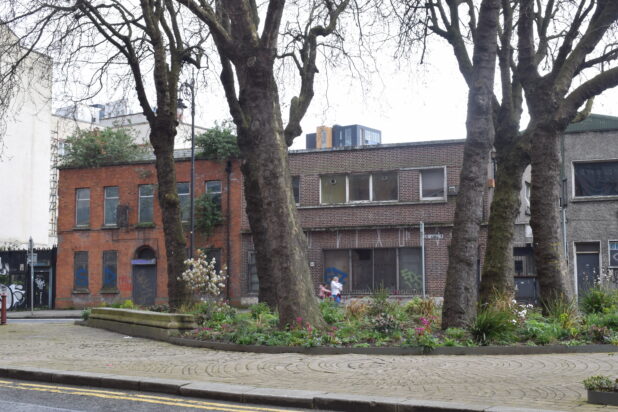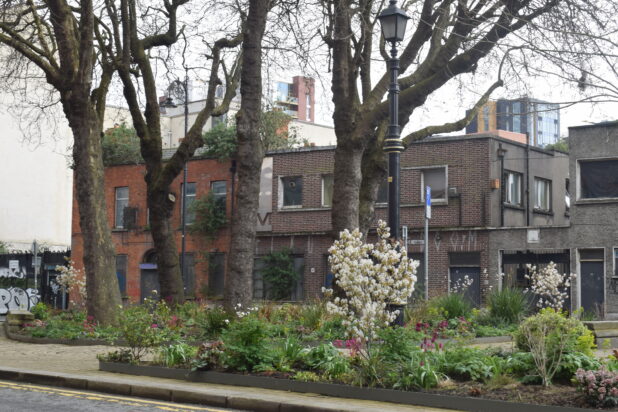Dublin 8 : OUR TOWN – Jack opines about Dublin’s planning decisions, our we losing our soul to poor planning?
In the Dublin City Ramblers 1970s hit song “The Rare Ould Times” composed by Pete St. John and later song by the greatest of them all Sheriff streets own Luke Kelly we hear from Sean Dempsey from Pimlico he reminisces about his upbringing and mourns the transformations Dublin has undergone since his youth, reminiscing the absence of Nelson’s Pillar, the Metropole ballroom, and the cherished “Royal” (Theatre Royal). He expressed disdain for the contemporary glass structures, the rise of modern office complexes and apartments lining the quays, but now the grey unyielding concrete has made its way from the city and into Sean Dempsey’s beloved liberties. In recent years, Dublin 8 has faced challenges with the construction of hotels, student accommodations, and buy-to-let apartments, majority owned by large international companies. These developments not only fail to contribute to the community but also pose a significant threat to its future.
I had my own Sean Dempsey moment not so long ago walking through the Liberties in the shadow of the obelisk Fountain stands two of my favourite local buildings standing side by side that of 32-35 James’s street this former steelworks site and the adjacent McCormack’s Dental Ltd. abounded for well over a decade was granted permission for 189 unit build to rent apartment block in April 2021. Though no demolition has started on this site, I fear it’s not long until we will we lose these beautiful facades that speak to us of Dublin’s past for more architecturally poor soulless apartment blocks that offer nothing to the streetscape. There seems to be a disconnect between the needs of the people of Dublin 8 and the priorities of the powers that be influenced possibly by external interests gas lighting the people of Dublin into believing any of this is to our benefit Shared living spaces have been offered as a housing solution, assuming that Dubliners must yearn for a return to tenement living.
Maybe we are all a little to blame, maybe we took our eye off the ball, believing someone was keeping watch for us but now we must accept our apathy has come at great cost. But it’s not yet to late so let us look at our neighbourhood with fresh eyes. We stand on the cusp of great change so now let us write the narrative for the city we want to live in and make it so I believe the protection of our built heritage is a cornerstone of this community narrative. Preserving our built heritage is fundamental to this community’s identity. The demolition of many historical sites, such as The O’Rahilly’s house near Herbert Park in 2019, and proposed developments like those on the historic Moore Street or St. Stephen’s Green Shopping Centre, does not align with the desires of Dubliners. These decisions serve external interests rather than the well-being of the community, in direct contradiction to the words of the Proclamation of the Irish Republic” We declare the right of the people of Ireland to the ownership of Ireland and to the unfettered control of Irish destinies, to be sovereign and indefeasible”.
Preserving buildings from redevelopment, even if they may not be architecturally significant, is crucial for maintaining the cultural and historical fabric of a city. Buildings that are not necessarily architecturally significant still hold immense cultural value as they often represent the daily lives, traditions, and experiences of ordinary people throughout our history. They serve as tangible reminders of the past, reflecting the evolution of a community over time. Preserving these buildings helps retain the collective memory and identity of a city, fostering a sense of belonging and continuity for its residents. Every city has its unique character and charm, shaped by its built environment. Even seemingly ordinary buildings contribute to the distinctiveness of a neighbourhood or district.
Preserving these buildings helps maintain the authenticity and character of urban spaces, creating a sense of place that residents and visitors alike can appreciate. Losing these buildings to redevelopment can result in the homogenization of urban landscapes, erasing the diversity and richness that make cities vibrant and dynamic. Redevelopment projects often prioritise economic growth and modernization, but they can also lead to the displacement of long-time residents and small businesses. By preserving existing buildings, particularly those in historic or culturally significant neighbourhoods such as Dublin 8, cities can mitigate the negative effects of gentrification and promote social equity. Preserving affordable housing and community spaces helps ensure that diverse populations can continue to thrive and contribute to the vitality of urban life. Retrofitting existing buildings for adaptive reuse is often more sustainable than demolishing them and constructing new structures.
Preserving buildings reduces the environmental impact associated with demolition waste and new construction materials, embracing adaptive reuse practices supports the principles of sustainability and responsible urban development. Preserving buildings from redevelopment can also yield economic benefits for cities. Historic preservation projects can stimulate local economies by creating jobs in construction, restoration, and tourism-related industries. Moreover, revitalising older buildings can attract new businesses, residents, and visitors to previously overlooked neighbourhoods, contributing to economic revitalization and community development. Preserving the city’s architectural heritage can be a catalyst for sustainable economic growth and cultural tourism. Dublin 8 is a vibrant and historically rich district with diverse communities and a unique identity with landmarks of huge historical significance and its very own type of charm.
The Liberties, in particular, holds a special place in Dublin’s history, it is known for its artisanal heritage, markets, and centuries-old streets. The area is also home to a mix of traditional pubs, trendy cafes and a haven for many of the city’s artists creating a dynamic and eclectic atmosphere, for these reasons and many more there truly is no place quite like Dublin 8. all those nice things been said There is a caveat, like the tagline of a closing down sale once it’s gone its gone, we must all of course learn to embrace change and modernisation but not at the cost of losing that what is irreplaceable in the process are built heritage, communities and are unique history can no longer be for sale.










